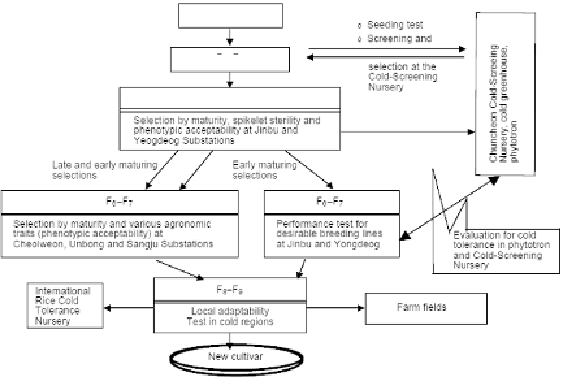Agriculture Reference
In-Depth Information
develop new promising lines and commercial varieties for the
Chilean rice ecosystem (FAO 2003).
Lee (2001) mentioned a system of Korean rice breeding to
make high yielding new cultivars with cold tolerance available
(Fig. 48).
F
1
Seeding test
Screening and
F
1
-F
3
selection at the
Cold-Screening
Nursery
F
4
-F
5
Selection by maturity, spikelet sterility and
phenotypic acceptability at Jinbu and
Yeogdeog Substations
Late and early maturing
selections
Early maturing
selections
F
6
-F
7
F
6
-F
7
Selection by maturity and various agronomic
traits (phenotypic acceptability) at
Cheolweon, Unbong and Sangju Substations
Performance test for
desirable breeding lines
at Jinbu and Yongdeog
Evaluation for cold
tolerance in phytotron
and Cold-Screening
Nursery
International
Rice Cold
Tolerance
Nursery
F
8
-F
9
Farm fi elds
Local adaptability
Test in cold regions
New cultivar
Fig.
48
Shuttle system for breeding cold tolerance rice, Korea (after NCES 1990).
Wide-compatibility varieties (WCVS) are a special class of
rice germplasm that is able to produce fertile hybrids of rice
germplasm, when crossed to both indica and japonica subspecies
to be broken and provided the possibility of developing inter-
subspecifi c hybrids in rice breeding programmes. However,
the major problem in utilizing the japonica source of tolerance
for developing improved cold tolerant indica rice cultivars is
the high spikelet sterility in F1 and succeed in generations.
Although, the degree and the frequency of partial sterility are








